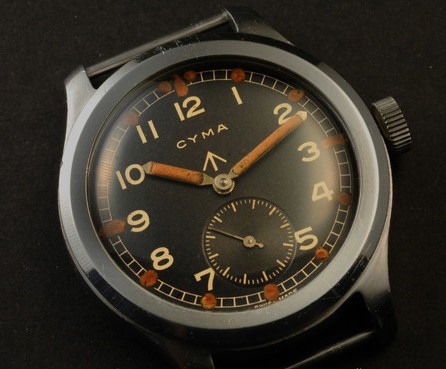Many old vintage watches—especially military watches—have gold or white-ish colored paint on their hands or the numbers on their dials. This paint could potentially be made of a phosphorescent compound mixed with radium. This compound would cause the hands/numbers to glow in the dark. This type of mixture was often chosen over others because of the superiority of its glow and longevity—unlike any other glow-in-the-dark paints, the radium-mixed paint could glow through an entire night (where other paints would lose their glows as the night progressed) and could potentially continue to glow for many years. The problem with vintage radium-painted watches was that their “glow” came from the radioactive decay of the radium itself, which had the very serious potential to cause various health problems to those who handled them frequently.
Identifying a Radium Watch
There are a handful of ways to identify a radium-painted watch:
- If there is an “R” or “Ra” located on the dial below the six o’clock marker. Beginning around the 1950’s or 60’s, watches dials began to be labeled this way in order to distinguish the element used in its markers. Similarly, a watch featuring tritium in its paint during this time would also be marked with two small “T”’s, or “T<25” labels near the same six o’clock marker. The “<25” label signified that the watch included less than 25 millicuries of radioactive tritium. (Tritium is a type of radioactive hydrogen that decays rather harmlessly into helium, and is far less dangerous than radium.)
- Use a Geiger counter or dosimeter to measure any present radiation levels. These instruments will be able to pick up the radiation of a vintage radium-painted watch, but will not be able to detect other, non-radioactive glow-in-the-dark compounds, or tritium-painted compounds—tritium gives off such little energy when it decays that special instruments would most likely be required to actually detect it.
- Make an educated guess concerning the age of the watch; the older it is estimated to be, the more likely it is to contain radioactive material.
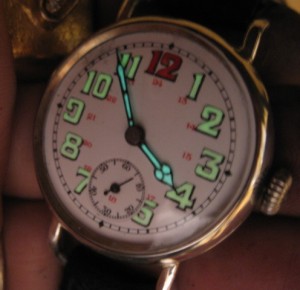
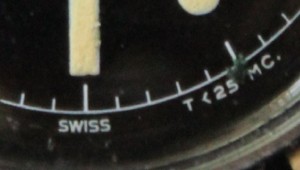
Radium Girls
Radium was used in watch paint beginning around 1910 well before the danger of radioactivity began to be understood. After WWI and through the 1920’s, radium-painted dials became very popular for both watches and clocks. Companies that produced radium-painted watch and clock dials, and other instruments typically hired young women to do the painting, and generally failed to disclose to them the potential hazards of working with the radioactive material.
While scientists and the owners of the U.S. Radium Corporation were well aware of the potential harm of interacting with radium, much of the rest of the population was lead to believe the opposite; in those days, radium was touted as a new miracle compound with fantastic medical potential—it was even believed to be a stomach cancer cure. Because of all this, workers were unsurprisingly given little-to-no warning of the health dangers of handling such radioactive materials. Workers were often encouraged to lick the tips of their paintbrushes in order to keep the tips pointed for more accurate painting, which resulted in many workers continually ingesting small amounts of radioactive material each workday. Women were also known to have painted their faces, teeth, and fingernails with the stuff for fun.
When the dangers of radioactive paint began to receive media attention in the 1920’s after numerous workers began to fall ill from unknown causes, investigations into the working environments of these companies showed just how lax their regard for the safety of their workers was; radioactive dust could be found in various places in company workrooms including on unused chairs, on different parts of workers’ bodies, and even their underclothes. While no regard was given for the safety of the painters, though, company chemists were instructed to use lead screens, masks, and tongs when dealing with the same materials.
In 1927 Raymond Berry, a New Jersey attorney, filed a lawsuit against U.S. Radium on behalf of Grace Fryer, a former U.S. Radium employee stricken with radium poisoning. Soon thereafter four other women with similarly severe medical problem were added to the lawsuit: Edna Hussman, Katherine Schaub, Quinta McDonald, and Albina Larice. The lawsuit asked for $250,000 for the medical expenses and pain of the women. Sensationalist newspapers quickly latched onto the court case due to the large popularity of radium-infused health products at the time and began referring to the five women as the “Radium Girls.”
After being delayed by U.S. Radium for months, the company eventually settled with the five women, agreeing to pay $10,000 and $600 per year in annuity to each woman while they lived, as well as all their legal and medical expenses. Although the women “won” their case, they all inevitably died in the 1920’s and 30’s from their earlier exposures to radium.

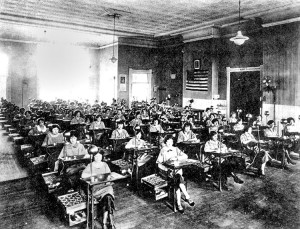
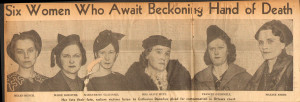
Risks of Radium
Ingesting and inhaling radium dust are the main ways to contract illnesses associated with radium poisoning, although making any sort of bodily contact with radium-infused materials can be harmful. Contact with radium can cause different bone diseases and cancers, as well as a host of other problems. Although ingesting radium is definitely harmful, it is less harmful to ingest it rather than inhale radium dust—according to the CDC, a large percentage (about 80%) of consumed radium should be quickly filtered out by the body. The other ~20% will enter a person’s bloodstream and be carried throughout their body, and especially to their bones, until eventually being filtered out of the body. Radium that is breathed in, however, may be settled in the lungs to cause lung damage in addition to being absorbed into the bloodstream.
Further Reading
Bill Kovarik’s “The Radium Girls”:
http://www.rst2.edu/ties/radon/ramfordu/pdffiles/The%20Radium%20Girls.pdf
The CDC on Radium: http://www.atsdr.cdc.gov/PHS/PHS.asp?id=789&tid=154#bookmark03

